|
On Saturday 6th July, we have a visit to Wild Woodbury, Bere Regis, with a walk of approximately 4km/2.5 miles across uneven ground around this rewilding community project guided by Dorset Wildlife Trust Ranger, Seb Haggett. There is a portaloo on site at the car park.
If you are used to walking poles it will be worth bringing them. Walking shoes/boots are advised and please bring a packed lunch and refreshments. The weather is looking good for Saturday, with dry, sunny spells forecast. There are ticks on site, along with longer vegetation, so trousers are recommended. Also bring along any wildlife spotting equipment, binoculars, cameras etc. Please let us know if you are planning to join the trip and where you will meet us. No dogs. Meet at the Nadder Centre car park at 9:30am or at 10:30am up a short track off Southbrook Road, opposite Eldon Road in Bere Regis. https://maps.app.goo.gl/qXbC482vgk4pZ6Qt6 What3words: permanent.kings.chef Those of you that came along to our meeting in January will recall the fascinating presentation by Rob Farrington of the work he has been leading for the past two and a half years to re-wild the 170-hectare site, south-east of Bere Regis. The plot acquired by Dorset Wildlife Trust was In September 2021 with plans to return what was previously intensively farmed arable land to its natural state. The goal was to create an example of sustainable land use, contribute to tackling the climate and ecological crises, reduce high nitrate levels in the area (and prevent them from entering Poole Harbour), and to engage the local community. In the first year of the project, the land was allowed to naturally regenerate: there was an immediate increase in biodiversity and abundance, with the site list reaching 1300 species. During 2023, the second year of the project, work was carried out to ‘re-naturalise’ the headwaters of the River Sherford that run through the site. More information: https://www.dorsetwildlifetrust.org.uk/blog/tag/wild-woodbury Anticipated end time: Returning to Tisbury by 3:30pm Mike Read is a wildlife photographer and he (and his wife) have spent many hours traversing the Somerset Levels recording the flora and fauna of this ancient land. For over 5,000 years, people have visited this area. Bordered by the sea at Bridgewater Bay, receiving the rain run-offs from the Mendips, Quantocks and Blackdown Hills, and being the flood plains of several low gradient rivers (the River Parrett, for example, declines by 11.5 inches over a stretch of 11 miles) the water levels are now more controlled than in ancient times and a variety of nature conservation organisations manage the land to support and encourage a wide and varied array of wildlife.
Having set out the parameters of the area, Mike introduced us to an ancient walkway, said to date from 3806 BCE precisely! This raised boardwalk was known to our ancestors as the Sweet Track and helped them to navigate their way through the reeds and vegetation, above the water while hunting and gathering their food and resources. Peat continues to be cut from the nutrient rich soils and reeds harvested for use in basket making and for thatch. Mike’s favourite product of the area is the apples used in cider making and having been drunk by everyone instead of the unclean water. Our talk started with a photograph of a telegraph pole with a curious carving of a bird on top. The bird was a dalmatian pelican. Remains of this species have been found preserved in the peat and so they must have lived there. We were treated to a selection of superb photographs of the Somerset Levels through the seasons, starting with spring and alder catkins, marsh marigold, lapwings, 6 species of heron, egrets, marsh harrier, peregrine, the heronry at Swale Wood (visited by several members last spring), the early nesting mistle thrush while it’s cousin, the song thrush, is still singing to attract a mate, and the first migrants, chiff chaff and blackcaps. Nestled down in the reeds, we saw images of bittern and then a series of shots of great crested grebe doing a cat display followed by a weed dance, all part of their courtship rituals. The number of curlews has increased since the nature bodies have had a say in the optimum level of the water. The first butterflies and dragonflies were photographed among the water lilies and iris while a hobby was captured with a dragonfly in its beak. In summer, the bees are swarming and the yellow and white flowers of spring are superseded by the darker, richer colours of great willowherb, purple loosestrife and tufted vetch. Swallows arrive and the great egret chicks fledge. Kingfisher, moorhens, mallards and others are hunted by buzzards and marsh harriers. Towards the end of the summer, apples ripen, ditches are cleared and migrants pass through including the whitethroat and osprey. Hops, hips, elderberries and blackberries glisten in the autumn sunshine and provide food for speckled wood and red admirals. Fungi appears including fairy ink caps and glistening ink caps. Flocks of lapwing grow in number day by day. Golden plover arrive from the northern UK and Iceland. Mike told us about the successful reintroduction programme of the common crane and how many pairs are now breeding on the levels and some pairs have moved away to South Wales. In winter, lapwings, golden plovers, black-tailed gobwits and cormorants can be seen and wetland fowl of all kinds will be displaying and wing flapping in order to attract a mate. During the winter months, it is the best time to see bearded tits, short-eared owls and barn owls and also the now world famous murmurations of starlings. All captured through Mike’s lens and accompanied by interesting and amusing anecdotes, we are eagerly anticipating our visit to the levels this summer. The society’s visit to Ham Wall is on Saturday June 8th, 2024. Emma Procter Our next meeting, at the Victoria Hall on Tisbury High Street on Thursday 14th March at 7:30pm (doors, and the bar will be open from 7:00) will hear from Mike Read who is going to share with us his view of ‘The land of the Somer people’.
Mike, who lives at Ringwood in Hampshire, has worked as a free-lance wildlife photographer for over 40 years. His pictures are often used as nature illustrations, including in books he has written or co-authored such as 'The Robin' & 'The Barn Owl' both published by Blandford Press and a number on aspects of the New Forest: 'New Forest Moods', 'Perfect New Forest', 'Spirit of the New Forest', 'Spirit of the New Forest Pony', and 'New Forest National Park' all published by Halsgrove Publishing and 'Red Kite Country' published by Wild Guides Ltd. The Land of the Somer People, is one of a number of talks Mike delivers to societies like ours, illustrated with pictures he has taken over the years. He will take us through a typical year on the Somerset Levels, a wonderful place to watch wildlife at any time of year. The Levels have changed greatly since Stone Age man first visited the area and laid bundles of hazel sticks to be able to cross the boggy ground. Over 5,000 years later, pollarded willows, pumping stations, drainage ditches or ‘rhynes’ and other man-made constructions, have created a very controlled landscape. But wildlife still thrives with birds, flowers and insects all enjoying the Levels’ landscapes and the nature reserves that have been established. In the spring and summer, flowers add colour to the place as do butterflies, dragonflies and damselflies. Birds include up to six species of the heron family, raptors such as marsh harriers, buzzards, peregrines and hobbies as well as huge flocks of wintering waders and wildfowl. There is the successful reintroduction of common cranes to the area and the marvellous spectacle of the weaving, ever-changing patterns of ‘murmurations’ as tens of thousands of starlings fly in to roost in the reedbeds at sunset, while hawks and harriers try to secure a final meal of the day. As an ambassador for Dark Sky International, Steve Tonkin gave us a comprehensive talk on the importance of doing all we can to reduce nocturnal light pollution. Not only does it cause a disruption to the normal life of a wide range of animals, but it is having a long term effect on species numbers. Bright lights at night cause confusion, leading to death on roads, predation by larger animals and fewer opportunities to mate.
We heard examples about robins who get exhausted, mistaking artificial lights for daylight, as they sing through the night and migrating birds who are disoriented by lights and fly into buildings. There are parts of the world where already crops have to be pollinated by hand; for instance, in parts of Canada for their blueberry crops and in parts of China for their apples because insect colonies have vanished. Steve warned that we still have a way to go in further decreasing the light pollution across the AONB, otherwise we risk losing our dark skies designation. The light pollution over Tisbury was a particular concern to see when he showed us the satellite imaging of the AONB. So how can we help? https://darksky.org/ shows the way with guidance on how to assess your own home lighting, particularly in making sure that any outdoor light is appropriately placed with motion sensor activation and downward facing beams in warm not blue tones, to minimise disruption to wildlife. We can also look around our own community to see whether there is unnecessary lighting on public buildings and seek to persuade decision makers to implement changes. The day was sunny with that slight September chill in the air and we marvelled at the greenness of the trees in Savernake Forest for this time of year. After a wet May and then regular bouts of rain, the trees were showing fewer signs of stress and had kept their leaves longer. Keith Lea had prepared a fascinating day of study and exploration for us as we went off the main paths and visited different sections of the forest.
One of the first tips he shared was the way to differentiate pedunculate from sessile oaks by inspecting the way the leaves and acorns attached to the twigs. Our alliterative aide memoire of sessile-stalk will hopefully stick with us, where the sessile oak has long stalks to its leaves, whereas the pedunculate oak has the leaves forming from barely visible short stalks. We had lively discussions about fungi, having spotted Shaggy parasol, Chicken in the woods, Beefsteak, Earthball and these tiny translucent white parasols perched up high on branches whose name we didn’t know. There were majestic ancient trees to marvel at and glades where trees formed circles round beaten down leaves and mast, or around grassy pastureland in the more open sections. Shifts in the scents of the forest and temperature surges were noticeable as we moved through the different sections. We had a truly immersive day in the life of the forest and Keith was an excellent leader, sharing his knowledge of the trees and wildlife. The end of summer always brings lots of wasps to interrupt our picnics or irritate us in pub gardens. Another member of the wasp family, the Asian Hornet has been in the news lately because of concern about its potential to colonise the UK. It was accidentally introduced into southern France, probably off a container ship, in 2004, since when it has spread rapidly across Europe and towards the Channel.
The Asian Hornet is a very effective predator of insects, including honeybees and other pollinators. It can cause significant losses to bee colonies, and potentially other native species. As one hornet can consume up to 300 bees a day the species could have a devastating impact on our bees if it becomes established. As a result, much effort has gone into publicising the threat and encouraging people to report any sightings. There is even an “Asian Hornet Watch” app to help you to do this. It provides useful photos of the Asian Hornet and other species with which it could be confused. This includes the continent’s only indigenous species, the European Hornet. You can use the app to report a sighting, ideally with a photo. The way to identify an Asian Hornet in three steps is to ask: 1) does is it look mostly black; 2) has it a wide orange stripe on 4th segment of the abdomen (body or “tail”); and 3) do its legs look as if they have been dipped in yellow paint? Taken together these factors clearly separate it from other candidates. Our European Hornet, which has is quite common in the south of England, is a handsome insect slightly larger than the Asian Hornet and about twice the size of a wasp. It has similar markings to the wasp but is chestnut brown and yellow rather than black and yellow. It is not nearly as aggressive as the wasp and will only sting humans if threatened. Indeed, males do not even have a sting. Like other wasps they make paper nests of chewed up wood or bark, often in hollow trees. We may see them foraging in good weather throughout the autumn before the newly mated queens go into hibernation ready to start a new nest in spring. The rest of the colony, including the old queen, dies by winter. You may see the queens stocking up on nectar from flowers prior to hibernation. Since 2016, nationally there have been 52 confirmed sightings of Asian Hornets and 45 nests destroyed. Most sightings have been in Kent and although there have been a few in Dorset and Hampshire, there have been no sightings in Wiltshire yet. It is certainly important to prevent the spread of the Asian Hornet, but we shouldn’t allow our concern to lead us to unnecessarily persecute our native, and largely harmless hornet species. Andrew Graham Meet at the Nadder Centre car park on Sat 3rd June at 10.30am or approximately 1 hour 15 minutes later at the Westhay Moor Reserve BA6 9TX. The car park is at OS ST 456 437, just north of the junction between Westhay Moor Drove and Dagg’s Lane Drove, between the villages of Westhay and Godney.
Distance, Difficulty and Footwear: Approximately 5 km/3 miles on flat gravel paths which may be a bit muddy if there has been recent rain. Good stout shoes should suffice rather than wellingtons. Bring a packed lunch and refreshments. This Field Trip has limited numbers. There may still be places if you've not yet signed up and want to come. Equally please let us know if you're on the list, but can no longer make the date. We are now using the email address [email protected] for organising lists for events, so please contact us there. 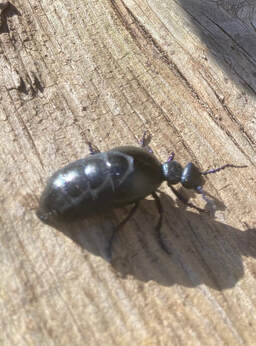 The committee have been enjoying a conflab on beetles. Dick found an interesting looking beetle near his house in bright sunshine, about 30mm long with a distinctive scaly pattern on its back and he sent an email around for suggestions on its species. And then did manage to track it down himself on the internet as the meloe proscerabaeus (Black Oil Beetle). Peter then passed on Tracy Adams’ nugget which she’d given to the Nadder Valley Cluster Group that “Black Oil Beetles have a fascinating but slightly gruesome life cycle which involves the larvae or the bizarrely named 'triungulins'. They climb up onto flowers & hitch a ride on the back of a solitary mining bee who take them into the nest & where they eat all the bee's eggs & pollen & nectar stores. The larvae develop in the burrows & emerge in spring as an oil beetle ready to mate & start the cycle again. They are a declining species so it is important to submit any records.” 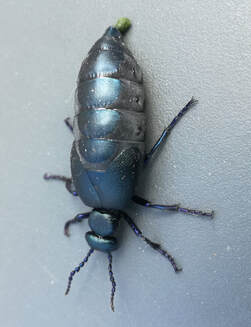 Andrew remarked “I get Oil Beetles on the wild bank in my garden and have been advised that you need to get a good look at the shape of the thorax to separate out the Black from the Violet Oil Beetle. I can't make the shape out from the pic and though there is certainly some violet there and the antennae are a bit bent both are features of both a Violet and a Black Oil Beetle. The Violets have a western distribution so it could be. I haven't seen any in my garden yet this year but saw one walking down Weaveland Road on Monday - well I was walking down the road, the beetle was walking down the pavement...” Andrew has added a photo of his own and finds it hard to decide whether his was a Black or a Violet. A green poo pellet graced the photo too, so we have further natural history findings to pass on! Andrew has also shared a useful factsheet link from BugLife about Oil Beetles.
Our AGM will start at 7.00pm for a brief run through of the minutes of last year’s meeting and the 2022 accounts. We urge as many members as possible to come along. The hall should be open half an hour before we start, so this year you can even enjoy the proceedings with a glass of wine in hand. 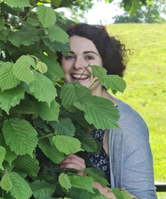 The talk will start at 7:30pm and we shall hear from Sarah Barnsley on 'Why hedgerows matter'. Sarah is Hedgerow Officer for the People’s Trust for Endangered Species, and a huge hedgerow enthusiast, working to promote these humble countryside heroes. Hedgerows form a key component of our natural heritage and provide many vital ecosystem services and functions. They connect up our countryside and provide essential food and shelter for much of our wildlife. From nesting birds to hibernating hedgehogs, well-managed hedges can provide abundant resources for animals, birds and all manner of insects. Yet, to maintain a healthy hedgerow network into the future, we need to manage hedgerows according to their natural lifecycle. Clive Whitbourn, National Trust Ranger, started his talk with a focus on Hambledon Hill, the 47 hectare hillfort which came to the National Trust in 2014. It is a Site of Special Scientific Interest and a photo from 1940 showed how bare the hillfort was 80 years ago. Now the hillfort is managed lightly, with scrub kept low and any erosion kept at bay with terrace reshaping to preserve the profile of the ramparts.
Clive showed us the methods they use with wooden frameworks buried deep to support hessian bags full of chalk, which bulk out any damaged areas, with turf from the ditch placed on top. The chalkland grasses grow through and thrive. He mentioned that the south and south-west ramparts of Hambledon Hill are best for butterflies. Cattle scraping for minerals – they can go on binges to self-medicate - and visitors wearing down paths, all play their part in erosion. Roboflail, a mechanical AI cutter, is being used on some of the NT sites to great effect to keep the scrub low and save the man hours for other tasks. The NT relies on volunteer help on many of their conservation projects. Hod Hill is Dorset’s largest Iron Age hillfort and is unusual because it has a Roman fort nestled within, built at a time when the invaders needed to defend their capture of this Durotriges stronghold. Clive showed us how the framework and hessian bag method was also used to repair a bridleway here. In terms of nature conservation, Texel sheep are good grazers and White Park cattle are brilliant for rough pastures. Yellow Rattle, which suppresses coarse grass growth, is doing well at Winn Green and there are plans this year to brush-harvest the seed from there and broadcast it to the newly purchased Clubmen’s Down, a 30 acre piece of arable. Across Clive’s patch and the various Downs and hillforts, uncommon species are being noted: Bee and the Great Butterfly orchids, and the unusual Autumn Lady’s Tresses; Waxcap fungi; Marsh, Silver-spotted and Danville Fritillaries, Grizzled Skippers, Small Blue and Adonis Blue butterflies; Great Green Bush-crickets and Glow worms. Clive’s talk gave us plenty of inspiration for visiting these places, particularly in the spring and summer! |
Photo: Avocets (Izzy Fry)
The headers display photos taken by our members. Do get in touch via the Contact Form if you'd like to submit a photo for selection.
Archives
May 2024
Categories
All
|
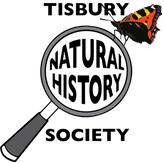
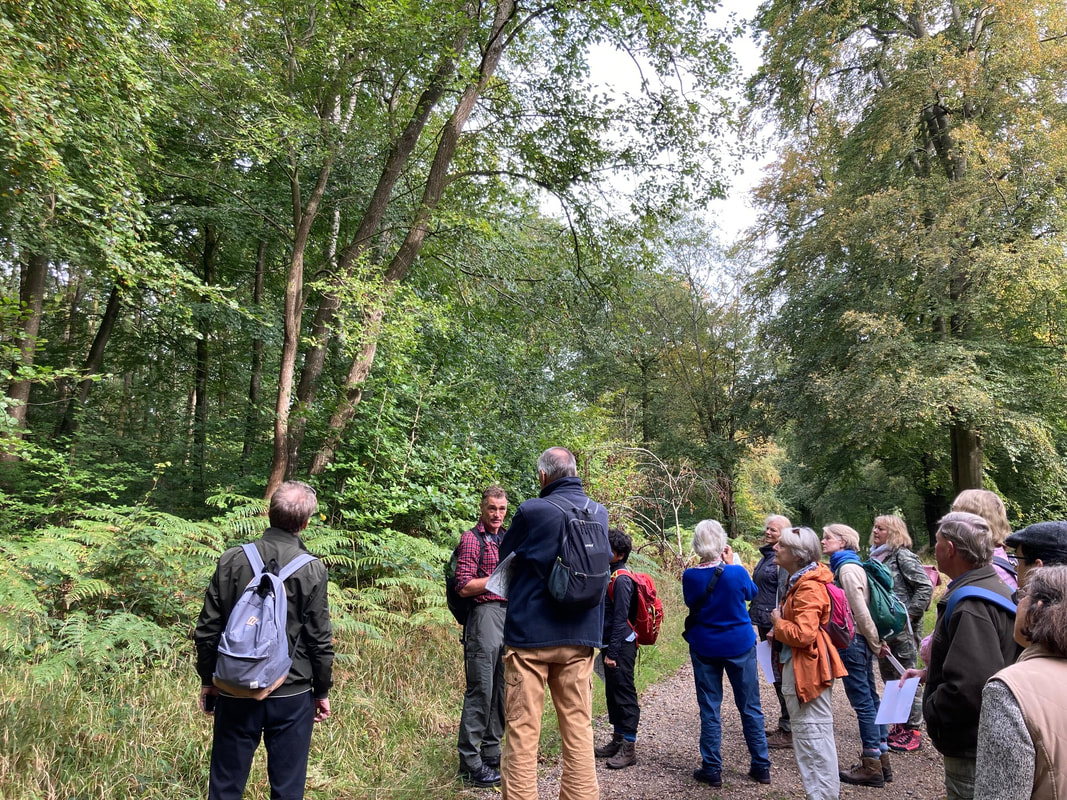
 RSS Feed
RSS Feed